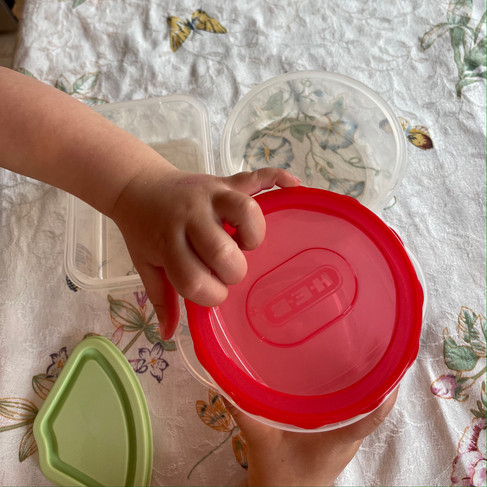Crafts & Play Inspiration for Infants & Toddlers
Updated: Aug 9, 2021
This decorate-the-letter packet was a big hit, and a perfect opportunity to practice the alphabet in an entertaining and tactile way! Print out the packet and "decorate" the inside of each letter using materials on hand (dried pasta or beans, large seeds, tissue paper, beads, bits of yarn, etc.). For extra fun, challenge your child to think of materials that begin with the letter they are decorating - e.g., 'B' is for bean, 'M' is for macaroni, etc. Download the free PDF for this packet below, and keep reading for a list of more activities and projects that are both fun and stimulating for infants and young toddlers, with some links and photos for inspiration.
More ideas for infants and toddlers:
1. String-along toys. So simple, yet so entertaining! Tie a string or piece of thick yarn to one of your child's toys (a wheeled toy will work best), and let them drag it around. Can they coordinate the movements of walking, grasping, and pulling? Can they problem-solve if the toy gets stuck or falls over? If your child is not yet walking, you can lay him/her on a play mat, drag the toy just out of reach and have them retrieve it by pulling the string. This is great for teaching cause-and-effect (via Lovevery). Pair this play with songs appropriate to the toy (e.g. wheels on the bus) or related sounds (e.g. "beep beep!") for extra auditory stimulation. What you'll need: toys with wheels, thick string or yarn.
2. Sensory bottles. Looking for opportunities for sensory exploration, but not keen on the mess? We loved this short video tutorial and instructions for three different sensory bottles. These can be used as cues for calm and self-regulation, and are especially useful for children dealing with ADHD, sensory processing disorder, or other disabilities leading to issues with self-control or overexcitement (via Understood). *Note: Be sure to glue on the tops of your bottles! What you'll need: a clear, empty plastic bottle or jar. a hot glue gun or superglue, warm water, food coloring, oil or corn syrup, glitter, and a funnel (optional, but very useful).

3. Texture board. We've also seen these referred to as "sensory boards" and "busy boards." This is another mess-free option for providing your little ones with opportunities for tactile stimulation and fine motor development. Check out this comprehensive list of sensory board ideas. What makes the time spent creating this worth it is the fact that your toddler will be occupied safely in one place for quite some time! Once your board has been made, easily swap out materials for new ones as your child and his or her interests evolve. What you'll need: a board or backing (a piece of wood, cardboard, posterboard, etc.), various stimulating materials (get creative! Think: old clothing and fabric scraps, floor or carpet samples, sandpaper, craft items such as buttons or pom poms, unused toys or keychains, etc.), and adhesive or tools to attach heavier items.

4. Floating catch. This is an activity that you likely have all the necessary materials for already! Blow bubbles or drop items of your choice (a balloon, feather, light scarf, etc.) from varying heights. Let your child crawl or run around to try to catch them. While mostly just fun, this activity is also great for developing gross motor skills and hand-eye coordination. What you'll need: bubbles or light objects (silk scarf, large feather, balloon, piece of tissue paper, etc.).

5. Sound jars. Yet another great way to stimulate the senses and promote exploration! This can be adapted for a variety of ages. With babies, opt for plastic and glue the lids in place so that they can shake the jars around. For toddlers, invite them to fill the containers themselves and experiment with the different sounds items can make. Which are louder? Which are softer? Are there any that make no sound at all? Here we used wooden beads, hair pins, and assorted twine/string. What you'll need: jars or containers with lids, small items (e.g., buttons, beads, coins, paper clips, marbles, etc.).
6. Container play. Watch your child become fascinated by assorted containers and lids, and you'll wonder why you even buy toys at all! Let them choose to stack, match different colors, pretend to eat or drink, or even fill the containers with toys (depending on their age and preferences). Read more about the benefits of container play (such as hand-eye coordination and object manipulation) here.
What you'll need: assorted containers and (plastic) bottles, lids and caps in a variety of shapes, sizes, and colors.
_edited.png)














Comments